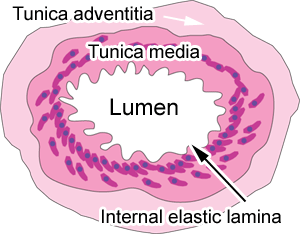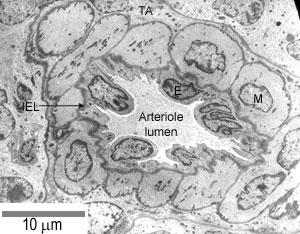There are three main types of arteries:
- Elastic arteries
- Muscular arteries
- Arterioles
Take a look at this cross-section through an elastic artery, and
identify the three main layers - tunica intima, tunica media and
tunica adventitia.
Elastic arteries:
These arteries that receive blood directly from the heart - the
aorta and the pulmonary artery.:
These need to be elastic because:
They are relatively thin compared to their diameter.
When the heart contracts, and ejects blood into these arteries,
the walls need to stretch to accommodate the blood surge, storing
energy. The arterial hydrostatic pressure that results from ventricular
contraction is the 'systolic blood pressure' (systole is greek for
contract).
Between heart contractions, the elastic walls recoil, to maintain
blood pressure, continuing to move blood even when ventricles are
relaxed. The arterial hydrostatic pressure between contractions
is the 'diastolic blood pressure' (diastole is greek for dilatation).The
walls of these arteries have lots of elastin.
Tunica adventitia - has small 'vasa vasorum' as
the large arteries need their own blood supply. Tunica media
is broad and elastic with concentric fenestrated sheets of elastin,
and collagen and only relatively few smooth muscle fibres.
Tunica intima is made up of an epithelium, which is a single
layer of flattened endothelial cells, together with a supporting
layer of elastin rich collagen. This layer also has fibroblasts
and 'myointimal cells' that accumulate lipid with ageing,
and the intima layer thickens, one of the first signs of atherosclerosis.
Muscular artery
These arteries distribute blood to various parts of the body. These
include arteries such as the femoral and coronary arteries. The
walls of these arteries have lots of smooth
muscle, which means that they are able to contract or relax
(dilate) to change the amount of blood delivered, as needed.
Comparing these arteries to the elastic arteries, the sheet of
elastin is now much reduced, and found at the border between the
tunica intima and tunica media
in a layer called the internal elastic layer (IEL)
which can be seen very clearly. Less well defined is the external
elastic layer (EEL), between the tunica media
and tunica adventitia. There is a well defined
circular layer of smooth muscle in the tunica media.
The tunica intima has an endothelium of flattened endothelial
cells. The tunica media is primarily a layer of smooth
muscle, with some elastin an collagen. muscle layer, and is sandwiched
between the IEL and EEL. The Tunica Adventitia is very
broad, and mostly contains collagen and elastin.
Can you identify the tunica intima and tunica media layers of this elastic artery?
Can you identify the tunica intima, IEL and tunica media of this muscular artery.
Arterioles:
This is a photo of some stained smaller arterioles. The TA layer
is difficult to see, but concentric rings of muscle can be seen
in the T.M. layer.
Can you find the arteriole?

This shows a diagram of an arteriole. The internal
elastic lamina layer is still present. The T.M. (tunica media layer)
has no more than six concentric rings of smooth muscle, and the
tunica adventia (T.A.) layer is approximately the same size as the T.M.
Larger arterioles have a lumen less than 100 to 300 µm in
diameter. Arterioles are small arteries that deliver blood to capillaries.
Arterioles control blood flow through capillary beds by contracting
or dilating the the size of the lumen, and therefore the tunica
media layer contains concentric rings of smooth muscle
to do this. This compartment is important in determining your blood
pressure as the narrow diameter of these blood vessels resists blood
flow, and the back pressure helps to stretch the walls of the arteries
during heart contractions.
The tunica intima is very thin, and mostly consists
of a single layer of squamous epithelium.The tunica media
consists almost entirely of a single layer up to six layers of smooth
muscle cells, and there is no EEL. The Tunica adventitia
is about the same size as the tunica media layer,
merges in with surrounding tissue.

This is an EM of a a very small arteriole. There is only one layer
of smooth muscle (M), but there is still an internal elastic layer (IEL).

